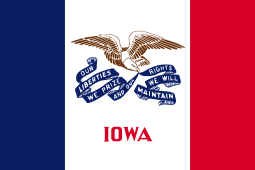Walter Halben Butler
Walter Halben Butler (February 13, 1852 – April 24, 1931) was a lawyer, teacher, newspaper publisher, and one-term Democratic U.S. Representative from Iowa's 4th congressional district, then located in northeastern Iowa.
Walter Halben Butler | |
|---|---|
.jpg) Louisville Courier-Journal, December 31, 1894 | |
| Member of the U.S. House of Representatives from Iowa's 4th district | |
| In office 1891–1893 | |
| Preceded by | Joseph H. Sweney |
| Succeeded by | Thomas Updegraff |
| Personal details | |
| Born | February 13, 1852 Springboro, Pennsylvania, U.S. |
| Died | April 24, 1931 (aged 79) Kansas City, Missouri, U.S. |
| Resting place | Forest Hill Cemetery, Kansas City, Missouri, U.S. |
| Political party | Democratic |
Biography
Born in Springboro, Pennsylvania on February 13, 1852,[1] Butler moved to Minnesota in 1868 with his parents, who settled in Mankato, in Blue Earth County.[2] He attended public and private schools, and graduated from the University of Wisconsin–Madison in 1875.[2] He was a wrestler and sprinter there, and is credited as the first to run the 100-yard dash in 10 seconds.[3]
After studying law, he was admitted to the bar in 1875 and commenced practice in Princeton, Wisconsin.[2] He moved to Iowa in 1876 and taught school at La Porte City until 1878, and at Manchester until 1880.[2]
He moved to West Union, Iowa, in 1883 and became owner and publisher of the Fayette County Union.[2] From 1885 to 1889, he served as superintendent of the Railway Mail Service's tenth division, at St. Paul, Minnesota.[2] He returned to West Union, and resumed his former newspaper pursuits.[2]
In 1890, Butler was nominated as a Democrat to run against incumbent Republican U.S. House Representative Joseph Henry Sweney from the 4th congressional district.[2] After defeating Sweney in the general election as part of a Democratic landslide, he served in the Fifty-second Congress.[2] In 1892 he was defeated in his first re-election bid, by former Republican Congressman Thomas Updegraff.[2] Butler served in Congress from March 4, 1891 to March 3, 1893.[2]
After leaving Congress, he returned to northeastern Iowa for five years.[2] He moved to Des Moines, Iowa, in 1897 and to Kansas City, Missouri, in 1907.[2] He engaged in the real estate and loan business and, later in banking.[2] He died in Kansas City on April 24, 1931.[2][3] He was interred at Forest Hill Cemetery in Kansas City.[2]
References
- History of Iowa, p. 35.
- Iowa Biographical Dictionary, p. 120.
- "First 10-Second Man and Legislator Dies". Jefferson City Post-Tribune. April 24, 1931. p. 1. Retrieved March 6, 2018 – via Newspapers.com.

Sources
Books
- Gue, Benjamin F. (1903). History of Iowa. IV, Iowa Biography. New York, NY: The century History Company.
- Onofrio, Jan (2000). Iowa Biographical Dictionary. St. Clair Shores, MI: Somerset Publishers, Inc. ISBN 978-0-403-09304-5.
External links
- United States Congress. "Walter Halben Butler (id: B001193)". Biographical Directory of the United States Congress.
- Walter Halben Butler at Find a Grave
| Preceded by Joseph H. Sweney |
Member of the U.S. House of Representatives from Iowa's 4th congressional district 1891–1893 |
Succeeded by Thomas Updegraff |
![]()

